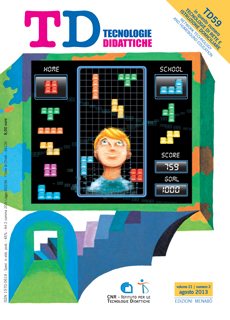WISEland, a learning environment for Homebound Education
Main Article Content
Abstract
Article Details
Authors who publish with this journal agree to the following terms:
- Authors retain copyright and grant the journal right of first publication with the work simultaneously licensed under a Creative Commons CC BY 4.0 Attribution 4.0 International License.
- Authors are able to enter into separate, additional contractual arrangements for the non-exclusive distribution of the journal's published version of the work (e.g., post it to an institutional repository or publish it in a book), with an acknowledgement of its initial publication in this journal.
- Authors are permitted and encouraged to post their work online (e.g., in institutional repositories or on their website) prior to and during the submission process, as it can lead to productive exchanges, as well as earlier and greater citation of published work (See The Effect of Open Access)
References
Benigno V., Repetto M. (2012). Homebound Education e istruzione scolastica: l’indagine nazionale sull’uso delle TIC nell’istruzione domiciliare. In G. Trentin (ed.). Reti e inclusione socio-educativa. Il sistema di supporto WISE . Franco Angeli: Milano, pp. 31-53.
Dettori G., Giannetti T., Paiva A., Vaz A. (eds.) (2006). Technology-Mediated Narrative Environments for Learning. Rotterdam, Taipei: Sense Publishers, Kaleidoscope.
Fazioli M.P. (2009). Effects of personalized narration on motivation in a web-based environment. Cambridge, UK: ProQuest publication.
Gunawardena C.N. (2005). Social presence theory and implications for interaction collaborative learning in computer conferences. International Journal of Educational Telecommunications, 1 (2-3), pp. 147-166.
Huang H., Rauch U., Liaw S. (2010). Investigatin learners’ attitudes toward virtual reality learning environments: Based on a constructivist approach. Computer & Education,55 (3), pp. 1171-1182.
Kalyuga S. (2007). Expertise reversal effect and its implications for learner-tailored instruction. Educational Psychology Review , 19, pp. 509-539.
Knowles M.S., Holton E.F., Swanson R.A. (1998). A theory of adult learning: andragogy. In The adult learner: the definitive classic in adult education and human resource development (5th ed.). Woburn, MA, USA: Butterworth Heinemann, pp. 35-72.
Mayer R.E. (2005). Principles of multimedia learning based on social cues: Personalization, voice, and image principles. In R. E. Mayer (ed.)., The Cambridge handbook of multimedia learning . New York, USA: Cambridge University Press, pp. 201-212.
Mandernach B. (2009). Effect of instructor-personalized multimedia in the online classroom. The International Review of Research in Open and Distance Learning , 10 (3) http://www.irrodl.org/index.php/irrodl/article/ view/606/1263 (ultima consultazione 30.05.2013).
Newmaster S., Lacroix C. A., Roosenboom C. (2006). Authentic learning as a mechanism for learner centeredness. International Journal of Learning, 13 (6), pp. 103-112.
Repetto M., Benigno V. (2012). WISEland: il percorso formativo sull’istruzione domiciliare. In G. Trentin (ed.). Reti e inclusione socio-educativa. Il sistema di supporto WISE . Milano : Franco Angeli, pp.213-241.
Repetto M., Bernava L. (2013). Un ambiente di au- toformazione sulla didattica domiciliare. Education 2.0 http://www.educationduepuntozero.it/tecnologie-e-ambienti-di-apprendimento/ambiente-autoformazione-didattica-domiciliare- 4062467594.shtml (ultima consultazione 21.02.2013).
Schworm S., Stiller K.D (2012). Does personalization matter? The role of social cues in instructional explanations. Intelligent Decision Technologies, Special Issue on Multimedia/Multimodal Human-Computer Interaction in Knowledge-based Environments , 6, pp. 105-111.

